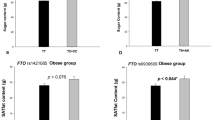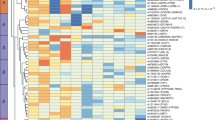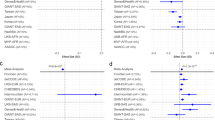Abstract
Common intronic SNPs in the human fat mass and obesity associated (FTO) gene are strongly associated with body mass index (BMI). In mouse models, inactivation of the Fto gene results in a lean phenotype, whereas overexpression of Fto leads to increased food intake and obesity. The latter finding suggests that copy number variants at the FTO locus might be associated with extremes of adiposity. To address this question, we searched for rare, private or de novo copy number variation in a cohort of 985 obese and 869 lean subjects of European ancestry drawn from the extremes of the BMI distribution, genotyped on Affymetrix 6.0 arrays. A ∼680 kb duplication, confirmed by real-time PCR and G-to-FISH analyses, was observed between ∼rs11859825 and rs9932411 in a 68-year-old male with severe obesity. The duplicated region on chromosome 16 spans the entire genome-wide association studies risk locus for obesity, and further encompasses RBL2, AKTIP, RPGRIP1L and all but the last exon of the FTO gene. Affected family members exhibit a unique obesity phenotype, characterized by increased fat distribution in the shoulders and neck with a significantly increased neck circumference. This phenotype was accompanied by increased peripheral blood expression of RBL2 with no alteration in expression of FTO or other genes in the region. No other duplications or deletions in this region were identified in the cohort of obese and lean individuals or in a further survey of 4778 individuals, suggesting that large rare copy number variants surrounding the FTO gene are not a frequent cause of obesity.
Similar content being viewed by others
Log in or create a free account to read this content
Gain free access to this article, as well as selected content from this journal and more on nature.com
or
References
Gerken T, Girard CA, Tung YC et al: The obesity-associated FTO gene encodes a 2-oxoglutarate-dependent nucleic acid demethylase. Science 2007; 318: 1469–1472.
Fredriksson R, Hagglund M, Olszewski PK et al: The obesity gene, FTO, is of ancient origin, up-regulated during food deprivation and expressed in neurons of feeding-related nuclei of the brain. Endocrinology 2008; 149: 2062–2071.
Church C, Lee S, Bagg EA et al: A mouse model for the metabolic effects of the human fat mass and obesity associated FTO gene. PLoS Genet 2009; 5: e1000599.
Fischer J, Koch L, Emmerling C et al: Inactivation of the Fto gene protects from obesity. Nature 2009; 458: 894–898.
Frayling TM, Timpson NJ, Weedon MN et al: A common variant in the FTO gene is associated with body mass index and predisposes to childhood and adult obesity. Science 2007; 316: 889–894.
Scuteri A, Sanna S, Chen WM et al: Genome-wide association scan shows genetic variants in the FTO gene are associated with obesity-related traits. PLoS Genet 2007; 3: e115.
Hinney A, Nguyen TT, Scherag A et al: Genome wide association (GWA) study for early onset extreme obesity supports the role of fat mass and obesity associated gene (FTO) variants. PLoS ONE 2007; 2: e1361.
Dina C, Meyre D, Gallina S et al: Variation in FTO contributes to childhood obesity and severe adult obesity. Nat Genet 2007; 39: 724–726.
Sallman AM, Rask-Andersen M, Jacobsson JA et al: Determination of the obesity-associated gene variants within the entire FTO gene by ultra-deep targeted sequencing in obese and lean children. Int J Obes (Lond) 2012; 37: 424–431.
Meyre D, Proulx K, Kawagoe-Takaki H et al: Prevalence of loss-of-function FTO mutations in lean and obese individuals. Diabetes 2010; 59: 311–318.
Cecil JE, Tavendale R, Watt P, Hetherington MM, Palmer CN : An obesity-associated FTO gene variant and increased energy intake in children. N Engl J Med 2008; 359: 2558–2566.
Berulava T, Horsthemke B : The obesity-associated SNPs in intron 1 of the FTO gene affect primary transcript levels. Eur J Hum Genet 2010; 18: 1054–1056.
van den BL, de Waal HD, Han JC et al: Investigation of a patient with a partial trisomy 16q including the fat mass and obesity associated gene (FTO): fine mapping and FTO gene expression study. Am J Med Genet 2010; 152A: 630–637.
Ahituv N, Kavaslar N, Schackwitz W et al: Medical sequencing at the extremes of human body mass. Am J Hum Genet 2007; 80: 779–791.
Dent R, Blackmore A, Peterson J et al: Changes in body weight and psychotropic drugs: a systematic synthesis of the literature. PLoS ONE 2012; 7: e36889.
Laakso M, Matilainen V, Keinanen-Kiukaanniemi S : Association of neck circumference with insulin resistance-related factors. Int J Obes Relat Metab Disord 2002; 26: 873–875.
Davies RW, Wells GA, Stewart AF et al: A genome-wide association study for coronary artery disease identifies a novel susceptibility locus in the major histocompatibility complex. Circ Cardiovasc Genet 2012; 5: 217–225.
Miller SA, Dykes DD, Polesky HF : A simple salting out procedure for extracting DNA from human nucleated cells. Nucleic Acids Res 1988; 16: 1215.
Howie BN, Donnelly P, Marchini J : A flexible and accurate genotype imputation method for the next generation of genome-wide association studies. PLoS Genet 2009; 5: e1000529.
Price AL, Patterson NJ, Plenge RM, Weinblatt ME, Shadick NA, Reich D : Principal components analysis corrects for stratification in genome-wide association studies. Nat Genet 2006; 38: 904–909.
McCarroll SA, Kuruvilla FG, Korn JM et al: Integrated detection and population-genetic analysis of SNPs and copy number variation. Nat Genet 2008; 40: 1166–1174.
Wang K, Li M, Hadley D et al: PennCNV: an integrated hidden Markov model designed for high-resolution copy number variation detection in whole-genome SNP genotyping data. Genome Res 2007; 17: 1665–1674.
Stratigopoulos G, LeDuc CA, Cremona ML, Chung WK, Leibel RL : Cut-like homeobox 1 (CUX1) regulates expression of the fat mass and obesity-associated and retinitis pigmentosa GTPase regulator-interacting protein-1-like (RPGRIP1L) genes and coordinates leptin receptor signaling. J Biol Chem 2011; 286: 2155–2170.
Conrad DF, Pinto D, Redon R et al: Origins and functional impact of copy number variation in the human genome. Nature 2010; 464: 704–712.
Bochukova EG, Huang N, Keogh J et al: Large, rare chromosomal deletions associated with severe early-onset obesity. Nature 2010; 463: 666–670.
Walters RG, Jacquemont S, Valsesia A et al: A new highly penetrant form of obesity due to deletions on chromosome 16p11.2. Nature 2010; 463: 671–675.
Speliotes EK, Willer CJ, Berndt SI et al: Association analyses of 249,796 individuals reveal 18 new loci associated with body mass index. Nat Genet 2010; 42: 937–948.
Willer CJ, Speliotes EK, Loos RJ et al: Six new loci associated with body mass index highlight a neuronal influence on body weight regulation. Nat Genet 2009; 41: 25–34.
Jarick I, Vogel CI, Scherag S et al: Novel common copy number variation for early onset extreme obesity on chromosome 11q11 identified by a genome-wide analysis. Hum Mol Genet 2011; 20: 840–852.
Engelen JJ, de Die-Smulders CE, Vos PT, Meers LE, Albrechts JC, Hamers AJ : Characterization of a partial trisomy 16q with FISH. Report of a patient and review of the literature. Ann Genet 1999; 42: 101–104.
Grunnet LG, Nilsson E, Ling C et al: Regulation and function of FTO mRNA expression in human skeletal muscle and subcutaneous adipose tissue. Diabetes 2009; 58: 2402–2408.
Jowett JB, Curran JE, Johnson MP et al: Genetic variation at the FTO locus influences RBL2 gene expression. Diabetes 2010; 59: 726–732.
Classon M, Salama S, Gorka C, Mulloy R, Braun P, Harlow E : Combinatorial roles for pRB, p107, and p130 in E2F-mediated cell cycle control. Proc Natl Acad Sci USA 2000; 97: 10820–10825.
Wang Q, Li YC, Wang J et al: miR-17-92 cluster accelerates adipocyte differentiation by negatively regulating tumor-suppressor Rb2/p130. Proc Natl Acad Sci USA 2008; 105: 2889–2894.
Classon M, Kennedy BK, Mulloy R, Harlow E : Opposing roles of pRB and p107 in adipocyte differentiation. Proc Natl Acad Sci USA 2000; 97: 10826–10831.
Fox CS, Liu Y, White CC et al: Genome-wide association for abdominal subcutaneous and visceral adipose reveals a novel locus for visceral fat in women. PLoS Genet 2012; 8: e1002695.
Mangge H, Renner W, Almer G, Weghuber D, Moller R, Horejsi R : Rs9939609 variant of the fat mass and obesity-associated gene and trunk obesity in adolescents. J Obes 2011; 2011: (Article ID 186368).
Pruim RJ, Welch RP, Sanna S et al: LocusZoom: regional visualization of genome-wide association scan results. Bioinformatics 2010; 26: 2336–2337.
Acknowledgements
The authors wish to thank the family members for their participation in this study. Supported by CIHR MOP2390941 (to RM and RD) and the Merck Frosst Canada Chair in Atherosclerosis Research (to RM).
Author information
Authors and Affiliations
Corresponding author
Ethics declarations
Competing interests
The authors declare no conflict of interest.
Additional information
Supplementary Information accompanies this paper on European Journal of Human Genetics website
Supplementary information
Rights and permissions
About this article
Cite this article
Davies, R., Lau, P., Naing, T. et al. A 680 kb duplication at the FTO locus in a kindred with obesity and a distinct body fat distribution. Eur J Hum Genet 21, 1417–1422 (2013). https://doi.org/10.1038/ejhg.2013.63
Received:
Revised:
Accepted:
Published:
Issue date:
DOI: https://doi.org/10.1038/ejhg.2013.63
Keywords
This article is cited by
-
Diving deep—multipronged investigations into RIPK1 as a risk factor for obesity
Nature Metabolism (2020)
-
RIPK1 gene variants associate with obesity in humans and can be therapeutically silenced to reduce obesity in mice
Nature Metabolism (2020)
-
Polygene Varianten und Epigenetik bei Adipositas
Medizinische Genetik (2017)



